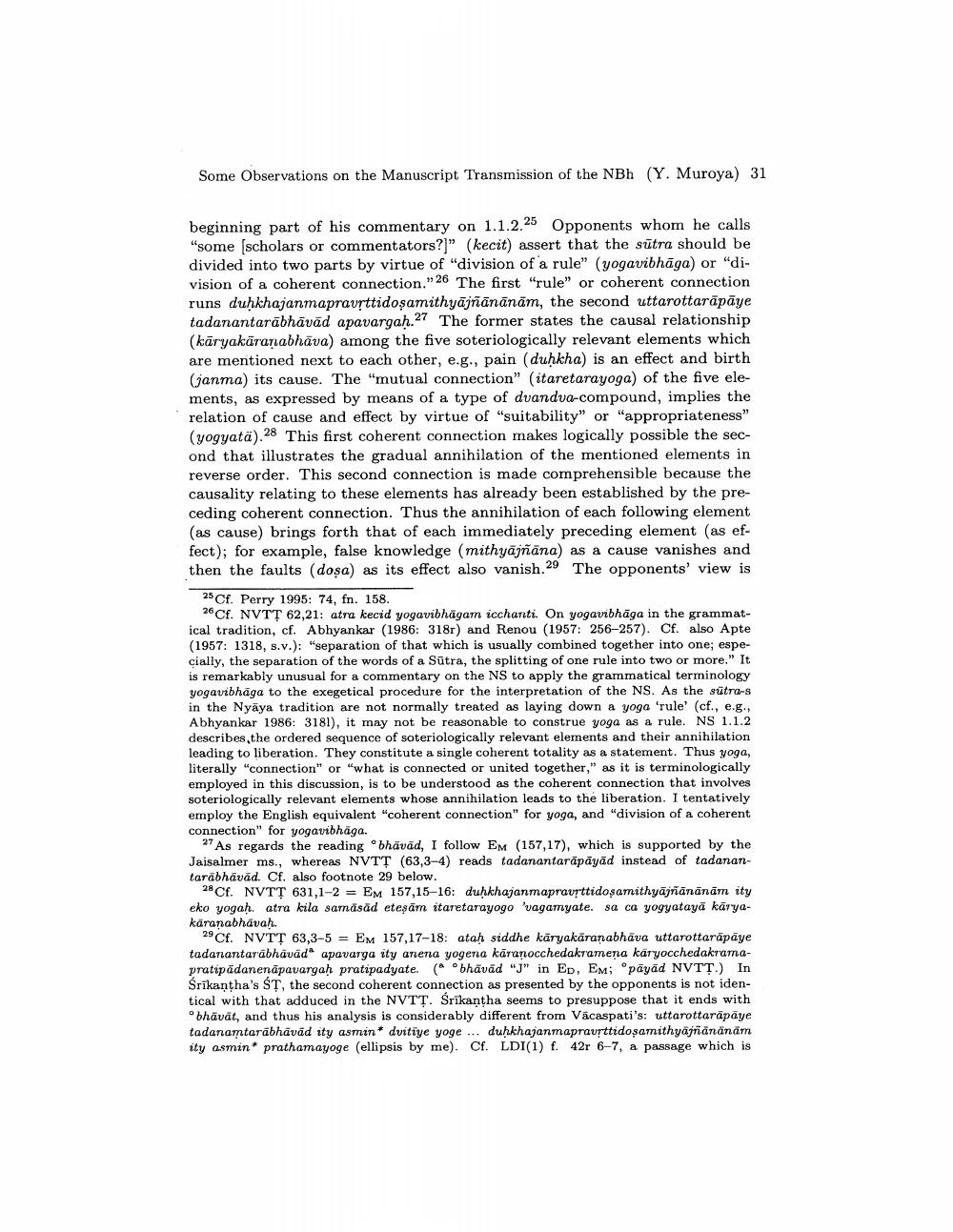Book Title: Some Observations On Manuscript Transmission Of Nyayabhasya Author(s): Yasutaka Muroya Publisher: Yasutaka Muroya View full book textPage 9
________________ Some Observations on the Manuscript Transmission of the NBh (Y. Muroya) 31 beginning part of his commentary on 1.1.2.25 Opponents whom he calls "some (scholars or commentators?]" (kecit) assert that the sutra should be divided into two parts by virtue of "division of a rule" (yogavibhāga) or "division of a coherent connection." 26 The first "rule" or coherent connection runs duḥkhajanmapravrttidoşamithyājñānānām, the second uttarottaräpāye tadanantarābhāväd apavargah.27 The former states the causal relationship (kāryakāraṇabhāva) among the five soteriologically relevant elements which are mentioned next to each other, e.g., pain (duhkha) is an effect and birth (janma) its cause. The "mutual connection" (itaretarayoga) of the five elements, as expressed by means of a type of dvandva-compound, implies the relation of cause and effect by virtue of "suitability" or "appropriateness" (yogyatä).28 This first coherent connection makes logically possible the second that illustrates the gradual annihilation of the mentioned elements in reverse order. This second connection is made comprehensible because the causality relating to these elements has already been established by the preceding coherent connection. Thus the annihilation of each following element (as cause) brings forth that of each immediately preceding element (as effect); for example, false knowledge (mithyājñāna) as a cause vanishes and then the faults (dosa) as its effect also vanish.29 The opponents' view is 25 Cf. Perry 1995: 74, fn. 158. 26 Cf. NVTT 62,21: atra kecid yogavibhāgam icchanti. On yogavibhāga in the grammatical tradition, cf. Abhyankar (1986: 318r) and Renou (1957: 256-257). Cf. also Apte (1957: 1318, s.v.): "separation of that which is usually combined together into one; especially, the separation of the words of a Sūtra, the splitting of one rule into two or more." It is remarkably unusual for a commentary on the NS to apply the grammatical terminology yogavibhāga to the exegetical procedure for the interpretation of the NS. As the sutra-s in the Nyaya tradition are not normally treated as laying down a yoga 'rule' (cf., e.g., Abhyankar 1986: 3181), it may not be reasonable to construe yoga as a rule. NS 1.1.2 describes the ordered sequence of soteriologically relevant elements and their annihilation leading to liberation. They constitute a single coherent totality as a statement. Thus yoga, literally "connection" or "what is connected or united together," as it is terminologically employed in this discussion, is to be understood as the coherent connection that involves soteriologically relevant elements whose annihilation leads to the liberation. I tentatively employ the English equivalent "coherent connection" for yoga, and "division of a coherent connection" for yogavibhaga. 27 As regards the reading bhāvād, I follow EM (157,17), which is supported by the Jaisalmer ms., whereas NVTT (63,3-4) reads tadanantarāpāyād instead of tadanantarābhāvād. Cf. also footnote 29 below. 28 Cf. NVTT 631,1-2 = EM 157,15-16: duhkhajanmapravrttidoşamithyājñānānām ity eko yogah. atra kila samäsäd eteşām itaretarayogo 'vagamyate. sa ca yogyatayā kāryakaranabhavah. 29 Cf. NVTT 63,3-5 = EM 157,17-18: atah siddhe kāryakäranabhäva uttarottaräpäye tadanantarabhavad" apavarga ity anena yogena kāranocchedakramena karyocchedakramapratipädanenāpavargah pratipadyate. ( bhāvād "J" in Ep, Em; pāyād NVTT.) In Srikantha's ST, the second coherent connection as presented by the opponents is not identical with that adduced in the NVTT. Srikantha seems to presuppose that it ends with bhävät, and thus his analysis is considerably different from Vacaspati's: uttarottaräpaye tadanamtarabhāvād ity asmin* dvitiye yoge ... duhkhajanmapraurttidosamithyajiananam ity asmin* prathamayoge (ellipsis by me). Cf. LDI(1) f. 42r 6-7, a passage which isPage Navigation
1 ... 7 8 9 10 11 12 13 14 15 16 17 18 19 20 21 22 23 24 25 26 27 28 29 30 31 32 33 34 35 36 37 38 39 40 41 42
